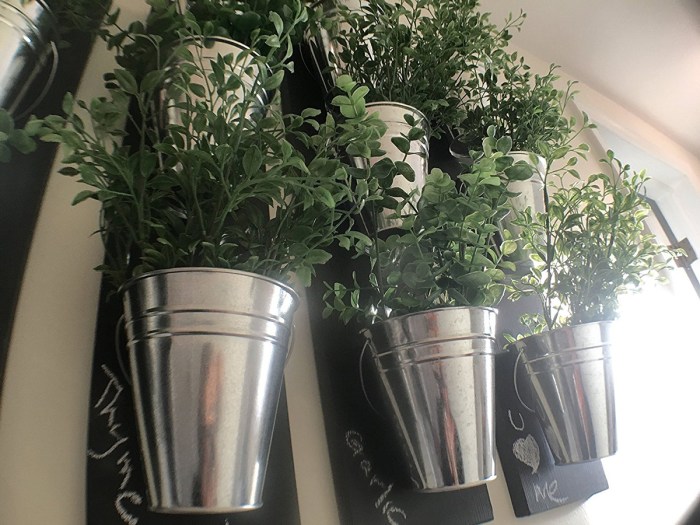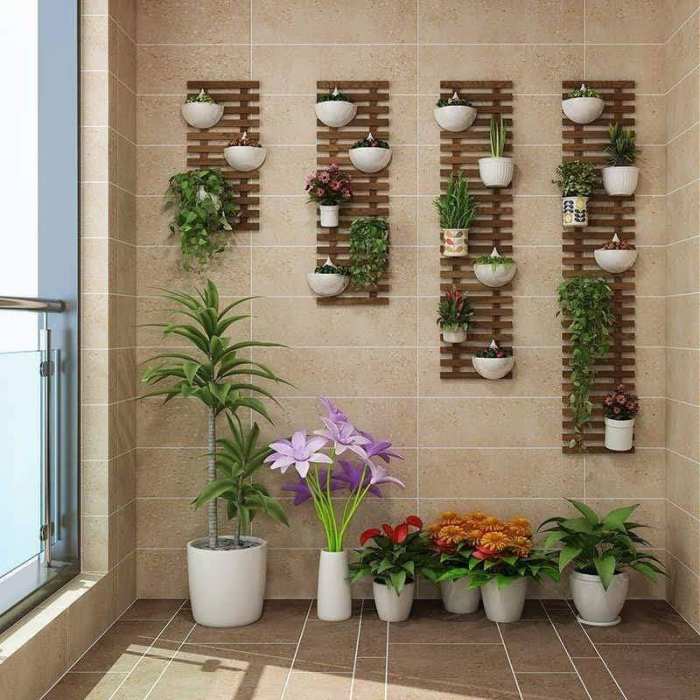Indoor wall plant pots are a stylish and space-saving solution for adding greenery to your home. From ceramic to metal, these versatile containers come in various shapes, sizes, and designs to complement any décor.
Whether you’re a seasoned plant enthusiast or a novice gardener, this comprehensive guide will provide you with all the essential information you need to create a thriving indoor wall garden.
Types of Indoor Wall Plant Pots
Indoor wall plant pots are an innovative way to add greenery to your home without taking up valuable floor space. They come in a variety of materials, shapes, sizes, and designs, so you can find the perfect one to match your décor.
The most common materials used for indoor wall plant pots are ceramic, plastic, metal, and wood. Ceramic pots are durable and easy to clean, but they can be heavy. Plastic pots are lightweight and inexpensive, but they may not be as durable as ceramic pots.
Metal pots are stylish and durable, but they can be expensive. Wood pots are natural and eco-friendly, but they may require more maintenance than other types of pots.
Indoor wall plant pots come in a variety of shapes and sizes. Some of the most popular shapes include round, square, rectangular, and oval. The size of the pot will depend on the size of the plant you want to grow.
Some pots are also designed with built-in drainage holes, which help to prevent the plant from becoming waterlogged.
The design of the pot can also be an important factor to consider. Some pots are simple and understated, while others are more elaborate and decorative. You can choose a pot that matches the style of your décor or that makes a statement on its own.
Materials Used
- Ceramic
- Plastic
- Metal
- Wood
Shapes and Sizes
- Round
- Square
- Rectangular
- Oval
- Built-in drainage holes
Design
Simple and understated
Elaborate and decorative
Mounting and Installation of Indoor Wall Plant Pots
Mounting indoor wall plant pots securely is crucial to ensure their stability and prevent any potential hazards. Different methods are available depending on the type of wall surface and the weight of the pot.
Drywall
For drywall, use heavy-duty anchors or toggle bolts to provide additional support. Drill a hole slightly smaller than the anchor and insert it, then screw in the hook or bracket for hanging the pot.
Concrete
For concrete walls, use concrete screws or bolts. Drill a hole slightly smaller than the screw and insert it directly into the wall, then hang the pot using a hook or bracket.
When it comes to indoor wall plant pots, there’s more to consider than just the pot itself. For optimal plant growth, proper lighting is crucial. A hanging plant light can provide the necessary illumination, enhancing the health and vitality of your indoor greenery.
Whether you’re a seasoned plant enthusiast or a novice gardener, a hanging plant light is an essential tool to keep your indoor wall plant pots thriving.
Brick, Indoor wall plant pots
For brick walls, use masonry nails or screws. Drill a small pilot hole and insert the nail or screw, then hang the pot using a hook or bracket.
It’s essential to use appropriate hardware and tools for each wall surface to ensure a secure installation. Overtightening can damage the wall or pot, so use caution and follow the manufacturer’s instructions carefully.
Plant Selection for Indoor Wall Plant Pots

Choosing the right plants for indoor wall plant pots is crucial for their health and aesthetic appeal. Factors to consider include light requirements, water needs, and growth habits. Selecting plants that complement each other in terms of color and texture can enhance the visual impact of the display.
Suitable Plant Species
Plants suitable for indoor wall plant pots include:
- Low-light plants:Ferns, snake plants, pothos, and ZZ plants thrive in low-light conditions, making them ideal for areas with limited natural light.
- Medium-light plants:Peace lilies, spider plants, and philodendrons require moderate light levels, suitable for rooms with windows or artificial lighting.
- High-light plants:Succulents, cacti, and flowering plants like orchids need bright, indirect light, often found near south- or west-facing windows.
Complementary Colors and Textures
To create a visually pleasing display, consider the colors and textures of the plants you choose. Plants with contrasting colors, such as deep green ferns and variegated pothos, can create a striking effect. Mixing different textures, like smooth snake plants and fuzzy ferns, adds depth and interest to the arrangement.
Maintenance and Care of Indoor Wall Plant Pots

Maintaining the health and vitality of plants in wall plant pots is essential for their well-being and the aesthetic appeal of your indoor space. Here are the key considerations for proper maintenance and care:
Watering
Watering requirements vary depending on the plant species, pot size, and environmental conditions. As a general rule, allow the top inch of soil to dry out before watering again. Use lukewarm water and water thoroughly until water drains from the bottom of the pot.
Avoid overwatering, as it can lead to root rot.
Indoor wall plant pots are a great way to add some greenery to your home without taking up too much space. If you’re looking for a more stylish way to display your plants, consider wall plant holders indoor . These holders come in a variety of styles and materials, so you can find one that fits your decor.
Plus, they’re easy to install and can be used to display plants of all sizes. With indoor wall plant pots, you can create a beautiful and unique indoor garden that will add life and color to your home.
Fertilizing
Fertilize your plants monthly during the growing season (spring and summer) with a balanced liquid fertilizer diluted to half strength. Avoid over-fertilizing, as it can damage the plant.
Pruning
Regular pruning is necessary to maintain the shape and size of your plants. Remove dead or diseased leaves and stems, and trim back any overgrown branches. Pruning also encourages new growth and flowering.
Accessing Plants for Maintenance
Accessing plants in wall plant pots for maintenance can be challenging. Use a step stool or ladder to reach higher plants, and be careful not to damage the walls or the plants themselves. Alternatively, consider using self-watering pots or hanging planters that can be easily removed for maintenance.
Troubleshooting Common Problems
*
-*Pests
Inspect your plants regularly for pests such as aphids, mealybugs, or spider mites. Treat infestations promptly with an appropriate insecticide.
-
-*Diseases
If you notice any signs of disease, such as yellowing leaves, brown spots, or wilting, isolate the affected plant and treat it with a fungicide.
-*Wilting
Wilting can be caused by underwatering, overwatering, or root rot. Check the soil moisture and adjust watering accordingly. If root rot is suspected, repot the plant into fresh soil.
By following these maintenance and care tips, you can ensure that your indoor wall plant pots thrive and bring beauty and freshness to your indoor space.
Design Ideas for Indoor Wall Plant Pots
Interior designers and homeowners alike are embracing the versatility of indoor wall plant pots to create stunning vertical gardens, living walls, and unique arrangements. These pots offer endless design possibilities, allowing you to transform any room into a vibrant and inviting oasis.
From space-saving solutions to eye-catching focal points, indoor wall plant pots cater to various styles and preferences. Whether you seek to enhance your living room, bedroom, or kitchen, these pots provide a creative way to incorporate greenery into your living spaces.
Vertical Gardens
Vertical gardens are a popular choice for small spaces or those looking to maximize wall space. By stacking multiple wall plant pots vertically, you can create a lush and vibrant green wall that adds depth and interest to any room.
Consider using a variety of plants with contrasting textures and colors to create a captivating display.
Living Walls
Living walls take vertical gardens to the next level, transforming entire walls into living, breathing ecosystems. These intricate arrangements often incorporate automated irrigation systems and specialized lighting to ensure optimal plant growth. Living walls not only beautify your space but also improve air quality and create a sense of tranquility.
Arrangements in Different Rooms and Styles
Indoor wall plant pots can complement any room’s décor, from modern to rustic. In living rooms, they can serve as statement pieces or create a cozy ambiance. In bedrooms, they can bring a touch of nature and promote relaxation. In kitchens, they can add a splash of color and provide fresh herbs for cooking.
Decorative Elements and Space Dividers
Beyond their practical uses, indoor wall plant pots can also be used as decorative elements or functional space dividers. By arranging them in unique patterns or mounting them at different heights, you can create visually appealing wall displays that add character to your space.
They can also be used to separate different areas of a room, creating a sense of privacy and division without the need for permanent walls.
Final Conclusion: Indoor Wall Plant Pots

With proper care and maintenance, indoor wall plant pots can bring beauty and vitality to your living space for years to come. So embrace the vertical gardening trend and transform your walls into a verdant oasis.
Commonly Asked Questions
What are the benefits of using indoor wall plant pots?
Indoor wall plant pots offer several benefits, including space-saving, improved air quality, and enhanced aesthetics.
How do I choose the right plants for indoor wall plant pots?
When selecting plants for indoor wall plant pots, consider their light requirements, water needs, and growth habits. Choose species that thrive in low-light conditions and have compact root systems.
How do I mount indoor wall plant pots securely?
Use appropriate hardware and tools to mount indoor wall plant pots securely. Follow the manufacturer’s instructions and ensure the wall can support the weight of the pot and plant.